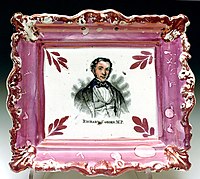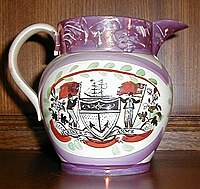
English delftware is tin-glazed pottery made in the British Isles between about 1550 and the late 18th century. The main centres of production were London, Bristol and Liverpool with smaller centres at Wincanton, Glasgow and Dublin. English tin-glazed pottery was called "galleyware" or "galliware" and its makers "gallypotters" until the early 18th century; it was given the name delftware after the tin-glazed pottery from the Netherlands,
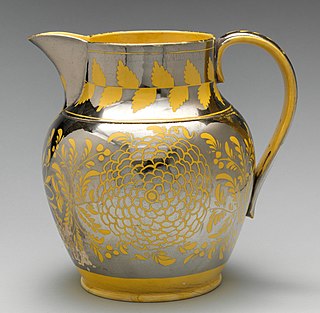
Lustreware or lusterware is a type of pottery or porcelain with a metallic glaze that gives the effect of iridescence. It is produced by metallic oxides in an overglaze finish, which is given a second firing at a lower temperature in a "muffle kiln", or a reduction kiln, excluding oxygen.

Hispano-Moresque ware is a style of initially Islamic pottery created in Al-Andalus, which continued to be produced under Christian rule in styles blending Islamic and European elements. It was the most elaborate and luxurious pottery being produced in Europe until the Italian maiolica industry developed sophisticated styles in the 15th century, and was exported over most of Europe. The industry's most successful period was the 14th and 15th centuries.

Transfer printing is a method of decorating pottery or other materials using an engraved copper or steel plate from which a monochrome print on paper is taken which is then transferred by pressing onto the ceramic piece. Pottery decorated using this technique is known as transferware or transfer ware.

Wedgwood is an English fine china, porcelain and luxury accessories manufacturer that was founded on 1 May 1759 by the potter and entrepreneur Josiah Wedgwood and was first incorporated in 1895 as Josiah Wedgwood and Sons Ltd. It was rapidly successful and was soon one of the largest manufacturers of Staffordshire pottery, "a firm that has done more to spread the knowledge and enhance the reputation of British ceramic art than any other manufacturer", exporting across Europe as far as Russia, and to the Americas. It was especially successful at producing fine earthenware and stoneware that were accepted as equivalent in quality to porcelain but were considerably cheaper.
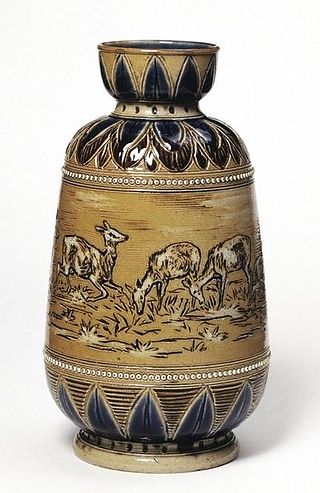
Royal Doulton is an English ceramic and home accessories manufacturer that was founded in 1815. Operating originally in Vauxhall, London, and later moving to Lambeth, in 1882 it opened a factory in Burslem, Stoke-on-Trent, in the centre of English pottery. From the start, the backbone of the business was a wide range of utilitarian wares, mostly stonewares, including storage jars, tankards and the like, and later extending to drain pipes, lavatories, water filters, electrical porcelain and other technical ceramics. From 1853 to 1901, its wares were marked Doulton & Co., then from 1901, when a royal warrant was given, Royal Doulton.

Mintons was a major company in Staffordshire pottery, "Europe's leading ceramic factory during the Victorian era", an independent business from 1793 to 1968. It was a leader in ceramic design, working in a number of different ceramic bodies, decorative techniques, and "a glorious pot-pourri of styles - Rococo shapes with Oriental motifs, Classical shapes with Medieval designs and Art Nouveau borders were among the many wonderful concoctions". As well as pottery vessels and sculptures, the firm was a leading manufacturer of tiles and other architectural ceramics, producing work for both the Houses of Parliament and United States Capitol.
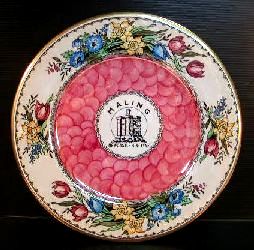
Maling pottery was produced in the north east of England for just over two centuries. The name of the pottery derives from the French surname of Malin. The family were Protestant Huguenots who fled their native land in the sixteenth century to escape the threat of religious persecution. They settled in England and prospered in a variety of business enterprises including coal, shipping and timber. Somewhere over the centuries the name was anglicized by the addition of a final "g".

The Herculaneum Pottery was based in Toxteth, Liverpool, England. between 1793/94 and 1841. They made creamware and pearlware pottery as well as bone china porcelain.

Art pottery is a term for pottery with artistic aspirations, made in relatively small quantities, mostly between about 1870 and 1930. Typically, sets of the usual tableware items are excluded from the term; instead the objects produced are mostly decorative vessels such as vases, jugs, bowls and the like which are sold singly. The term originated in the later 19th century, and is usually used only for pottery produced from that period onwards. It tends to be used for ceramics produced in factory conditions, but in relatively small quantities, using skilled workers, with at the least close supervision by a designer or some sort of artistic director. Studio pottery is a step up, supposed to be produced in even smaller quantities, with the hands-on participation of an artist-potter, who often performs all or most of the production stages. But the use of both terms can be elastic. Ceramic art is often a much wider term, covering all pottery that comes within the scope of art history, but "ceramic artist" is often used for hands-on artist potters in studio pottery.

Davenport Pottery was an English earthenware and porcelain manufacturer based in Longport, Staffordshire. It was in business, owned and run by the Davenport family, between 1794 and 1887, making mostly tablewares in the main types of Staffordshire pottery.
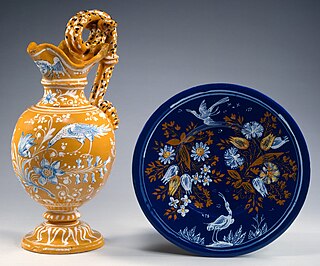
The city of Nevers, Nièvre, now in the Bourgogne-Franche-Comté region in central France, was a centre for manufacturing faience, or tin-glazed earthenware pottery, between around 1580 and the early 19th century. Production of Nevers faience then gradually died down to a single factory, before a revival in the 1880s. In 2017, there were still two potteries making it in the city, after a third had closed. However the quality and prestige of the wares has gradually declined, from a fashionable luxury product for the court, to a traditional regional speciality using styles derived from the past.

North Shields Pottery was an English pottery manufacturer that created earthenware ceramics from circa 1814 to circa 1913 under a succession of owners and company names.
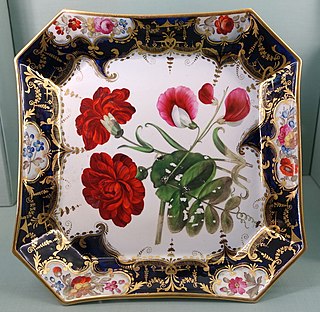
Coalport, Shropshire, England was a centre of porcelain and pottery production between about 1795 and 1926, with the Coalport porcelain brand continuing to be used up to the present. The opening in 1792 of the Coalport Canal, which joins the River Severn at Coalport, had increased the attractiveness of the site, and from 1800 until a merger in 1814 there were two factories operating, one on each side of the canal, making rather similar wares which are now often difficult to tell apart.
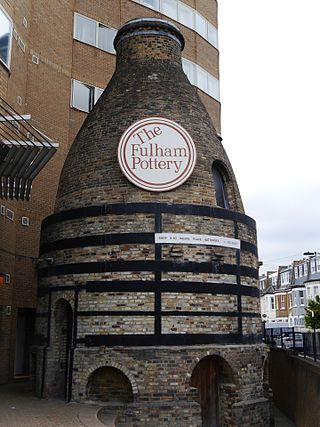
The Fulham Pottery was founded in Fulham, London, by John Dwight in 1672, at the junction of New King's Road and Burlington Road, Fulham, not far from Putney Bridge. Dwight is the earliest clearly documented maker of stoneware in England, although immigrant Dutch or German potters were probably active several decades before. By 1690 there was a rival stoneware operation in Fulham, run by the Dutch Elers brothers, who after a few years went off to become important early figures in transforming the Staffordshire pottery industry.

The Ridgway family was one of the important dynasties manufacturing Staffordshire pottery, with a large number of family members and business names, over a period from the 1790s to the late 20th century. In their heyday in the mid-19th century there were several different potteries run by different branches of the family. Most of their wares were earthenware, but often of very high quality, but stoneware and bone china were also made. Many earlier pieces were unmarked and identifying them is difficult or impossible. Typically for Staffordshire, the various businesses, initially set up as partnerships, changed their official names rather frequently, and often used different trading names, so there are a variety of names that can be found.

The Lowestoft Porcelain Factory was a soft-paste porcelain factory on Crown Street in Lowestoft, Suffolk, England, which was active from 1757 to 1802. It mostly produced "useful wares" such as pots, teapots, and jugs, with shapes copied from silverwork or from Bow and Worcester porcelain. The factory, built on the site of an existing pottery or brick kiln, was later used as a brewery and malt kiln. Most of its remaining buildings were demolished in 1955.

Leeds Pottery, also known as Hartley Greens & Co., is a pottery manufacturer founded around 1756 in Hunslet, just south of Leeds, England. It is best known for its creamware, which is often called Leedsware; it was the "most important rival" in this highly popular ware of Wedgwood, who had invented the improved version used from the 1760s on. Many pieces include openwork, made either by piercing solid parts, or "basketwork", weaving thin strips of clay together. Several other types of ware were produced, mostly earthenware but with some stoneware.

The original Castleford Pottery operated from c. 1793 to 1820 in Castleford in Yorkshire, England. It was owned by David Dunderdale, and is especially known for making "a smear-glazed, finely moulded, white stoneware". This included feldspar, giving it a degree of opacity unusual in a stoneware. The designs typically included relief elements, and edges of the main shape and the panels into which the body was divided were often highlighted with blue overglaze enamel. Most pieces were teapots or accompanying milk jugs, sugar bowls and slop bowls, and the shapes often derived from those used in contemporary silversmithing.

Mina'i ware is a type of Persian pottery developed in Kashan, Iran, in the decades leading up to the Mongol invasion of Persia in 1219, after which production ceased. It has been described as "probably the most luxurious of all types of ceramic ware produced in the eastern Islamic lands during the medieval period". The ceramic body of white-ish fritware or stonepaste is fully decorated with detailed paintings using several colours, usually including figures.




